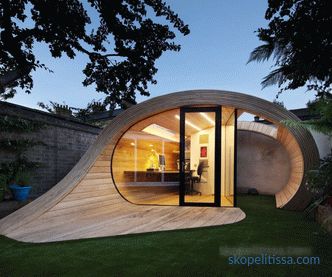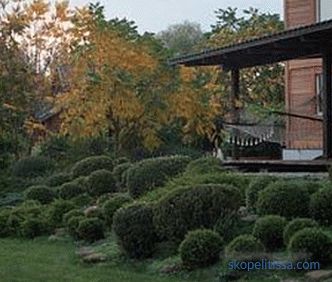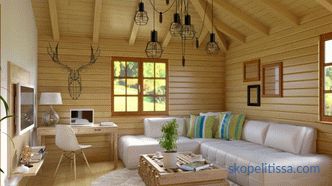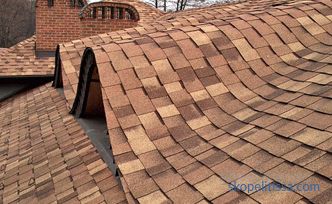Many dream of their own bath in the courtyard of a private house or cottage. After all, in addition to washing, it can be used for various wellness sessions. But what is better to build a bath? Properly chosen material affects the quality and strength of the building, as well as its useful life. When choosing a finish you need to take into account that the inner surfaces will be constantly exposed to steam and high temperature. There are various options for materials, but you need to give preference to high quality products.
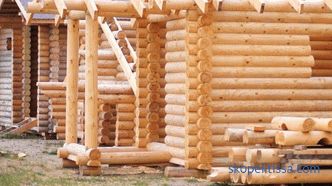
requirements. This is due to the fact that they are often heated with firewood. Criteria when choosing a material a small amount, but they should definitely be considered, otherwise the functionality of the bath can be quite badly violated, and its use will be expensive and inconvenient.
When choosing from which it is better to build a bath, you will need to take into account a number of specific criteria. In addition to strength, materials should have the following characteristics:
- Thermal insulation properties. Thanks to this, it will be possible to maintain the microclimate of the bath without extra costs of firewood or any other fuel.
- Protection against strong temperature extremes and high humidity levels.
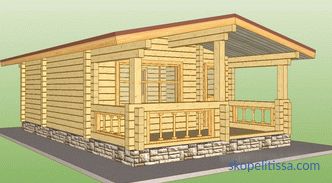
In addition to the considered parameters, the size of the future building, its location on the ground and financial opportunities of the developer. It is also extremely important to consider the quality of the purchased products. So, wood should have an average humidity and high-quality processing. In addition to wood, a large number of materials are used, each of which has its own strengths and weaknesses.
Popular materials for building a bath
There are a huge number of options for building a sauna. When choosing from which to build a bath, most often pay attention to the following materials:
- Wood.
- Aerated concrete structures.
- Expanded clay.
- Brick.
- Arbolit.
- Slag.
All the listed materials are perfect for building a bath. Their properties and characteristics are quite different, so it is recommended that you carefully study them before choosing.
Tree for building a bath
When asking what to build a bath for, many experts most often advise wood. You can use different types of wood, the parameters of which vary greatly. For industrial options include:
- Pine. This breed has natural protection against mold or insects, in the form of resin. The tree has a high moisture resistance. Pine is quite popular, you can buy it in any construction market. It has a low price in comparison with other species. The disadvantages can be attributed to "crying" at high temperatures, which will require additional treatment against rotting.
- Lipa. It is extremely easy and convenient to work with such a tree. It is ideal for building a sauna, as it has an excellent level of heat resistance. But it should be borne in mind that without finishing linden darkens, it is also susceptible to moisture.
- Aspen. Immune to moisture, has a high level of density. During the construction of this breed gives a slight shrinkage. It has a long service life and an attractive red color. By cons can be attributed to a fairly high cost and complex processing due to the density.
- Fir. This type is rarely used in construction, as it is rotting and has a low strength.
- Alder. It has a high cost, but it is of good quality. It gives a slight shrinkage and has a beautiful red color. It is easy to work with such a breed, it does not twist. But in the process of operation darkens and rot.
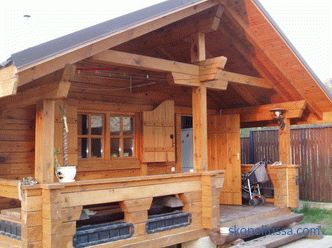
A log cabin and a bar are also quite often used. The frame is environmentally friendly material. After construction, interior and exterior decoration will not be necessary, as the log is attractive. Also, log houses have an excellent level of thermal insulation. The disadvantages include a large shrinkage after erection, cracking and bending of the material during construction and operation.
The beam is more protected from mechanical damage, it is additionally treated with solutions that provide protection from mold and fire. It should be borne in mind that building a bath on the basis of a tree requires experience and skills. Need to work carefully and not rush.
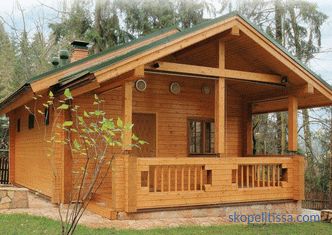
On our site you can find the contacts of construction companies that offer the service of designing and building a bath.Directly to communicate with representatives, you can visit the exhibition of houses "Low-rise Country".
The technology of manual cutting and how much does a cedar bath cost, see the following video:
Aerated
If a question arises, from which blocks it is better to build a bathhouse, many prefer gas concrete. Aerated concrete blocks are made on the basis of cement, silica sand and frothers. Products are processed in a special way, which provides them with high strength.
The advantages of using such a material include:
- Fire resistance. This is an extremely important criterion for the material on the basis of which the sauna will be constructed.
- Excellent strength, which only grows after time.
- Low weight. This nuance simplifies construction and allows you to abandon the foundation.
- Ease of processing. The material is easy to saw and drill.
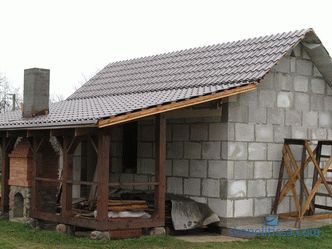
The main disadvantages include a rather high price and ability to absorb and store moisture. So before using aerated concrete for a bath, it is treated with special solutions. Also, during the construction of the building, you will need to take extra care to create steam insulation.
Another distinctive feature of aerated concrete is its mounting on a special glue, which is used as a substitute for cement composition. It is better not to use cement, since the blocks will absorb moisture from it, which will lead to a decrease in thermal insulation.
Expanded clay
This product is a material based on cement, expanded clay, foamed and baked clay. The advantages of this choice include non-toxicity, poor moisture absorption and low thermal conductivity. Also, these designs have a small weight, which will abandon the base and a good savings. Bath based on this material needs a small amount of insulation. Resistance to low temperature at expanded clay is 5 times greater than that of gas blocks, which ensures a long service life. Also a significant advantage is the lack of shrinkage after construction.
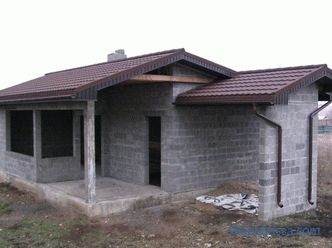
The thermal conductivity of such a material may vary depending on the grain size of the filler. This figure can vary from 0.15 to 0.45. The larger the grain, the lower the level of thermal conductivity and density. For the installation of such blocks suitable conventional mortar based on cement and sand or special adhesives. When building a bath, insulation will need to be carried out indoors. Basalt wool or foil layers are suitable for this.
Brick
Such material has the following indisputable advantages:
- Long service life. Brick baths can stand for more than 100 years, while the service life of wooden buildings does not exceed 20 years.
- Attractiveness. The brick will not need to be processed with any decorative solutions. It is suitable for the creation of any design structures.
- Fire resistance. Unlike wood, brick is not affected by fire.
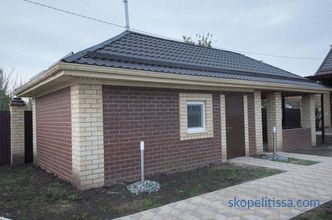
It might be interesting! In the article on the following link read about how to build a bath.
But a brick has a number of drawbacks, especially when it comes to building a bath. These include:
- The need to build a strip base. This is quite an expensive and lengthy procedure.
- It takes longer to warm up the brick. It takes no more than 1.5 hours to warm a wooden bath, and for brick construction it will take much more time and fuel.
- Poor ventilation. Brick surfaces are badly breathable.
- High price.
It will take a long time to build. It will take a while to wait for the concrete to dry, and it will also take time to lay the surfaces.
Because of the long life and resistance to fire, many use brick. To get rid of some of the drawbacks of such a choice, experts recommend using the following tips:
- In order to save, it is best to purchase a red and a half red brick.
- It will be necessary to think carefully about the ventilation system, leave special gaps for this.
- When choosing cement, it is worth using a grade of at least M200. Only they guarantee durability and high thermal insulation.
- It is better to perform warming of a bath on the basis of a brick from the inside, so as not to spoil the attractiveness of the building.
Baths on the basis of wood concrete
Such material was popular in Soviet times. Arbolitovy blocks for 90% consist of wood waste. The required block size can be obtained with a chipper or crusher. Also, such structures must be poured with cement, which contains calcium and liquid sodium.Such components will accelerate the solidification of the solution and protect the wood from deformation.
The advantages of using arbolit include:
- Low thermal conductivity.
- Ability to retain a comfortable indicator of moisture in the building.
- Environmental safety material.
- Low price.
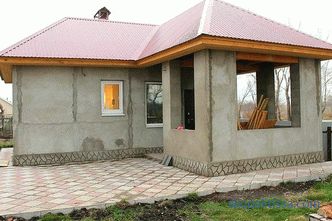
When buying arbolit for a bath, the main thing is to choose high-quality, durable units. It is also worth considering that such a material has a heat capacity similar to that of air. Because of this, in the sauna, the air warms up first and only then the surface. In brick buildings everything happens the other way around.
Outside arbolit walls are best sheathed with bricks, clapboard or wood with protection from moisture. For building a bath clapboard cladding will be the most preferred solution due to its low cost.
Slag stones
This cheap material is produced by pouring concrete of various wastes, in the form of combustion products of coal, sawdust and other things. There are empty and full-bodied cinder blocks. The advantages of this choice include:
- Long service life, which is about 50 years.
- Fire protection.
- Low price, compared to wood or brick.
- Different filling options will help you choose the most appropriate solution.
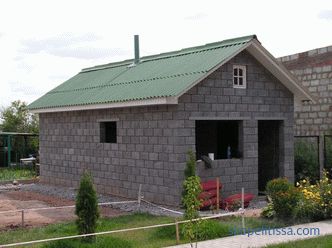
The disadvantages of using cinder blocks include hygroscopicity, which will require waterproofing of the material. Also a disadvantage is the high thermal conductivity, because of which the bath will need to provide additional thermal insulation. Another distinctive feature of the cinder block is that before using it in construction, it must be weathered in the air for at least a year. Because of this, the construction will be greatly delayed.
More information about the choice of material for the construction of the bath is told in this video:
Construction of frame baths
Recently for building baths were often used frame. The advantages of this choice include:
- Light weight of the structure, which will allow installation on a light basis.
- High construction speed. Construction takes no more than 3 weeks, it is 3 times faster than using bar or brick.
- Excellent level of thermal insulation.
- Construction is possible at any time of the year.
- Surfaces are perfectly breathable, due to which in the bath there is an excellent microclimate.
- Environmental safety of materials.
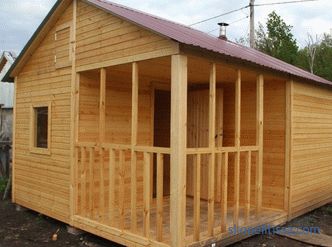
This solution also has its disadvantages. These include:
- Within 2 years, there is quite a strong shrinkage. On average, it is 10 cm. To reduce this figure, you will need to apply chamber drying materials.
- Additional costs for insulation and lining. The frame itself is not distinguished by high cost, but interior and exterior decoration will require investments.
- Difficulty when choosing insulation. You will need to use materials that are not afraid of fire and moisture.
The frame constructions will allow for a good saving, while they are able to provide an acceptable quality of construction.
It might be interesting! In the article on the following link read about turnkey two-storey baths.
What to look for when choosing materials for a bath, see the following video:
Total
It is difficult to say for sure from which to build a bath is best. The choice of material depends on the personal plans and preferences of the developer. If long life is important, a brick will be the best choice. For a quick warm-up of the bath, it is better to give preference to wood or various blocks. The best option today is the construction of the bath on frame technology.
